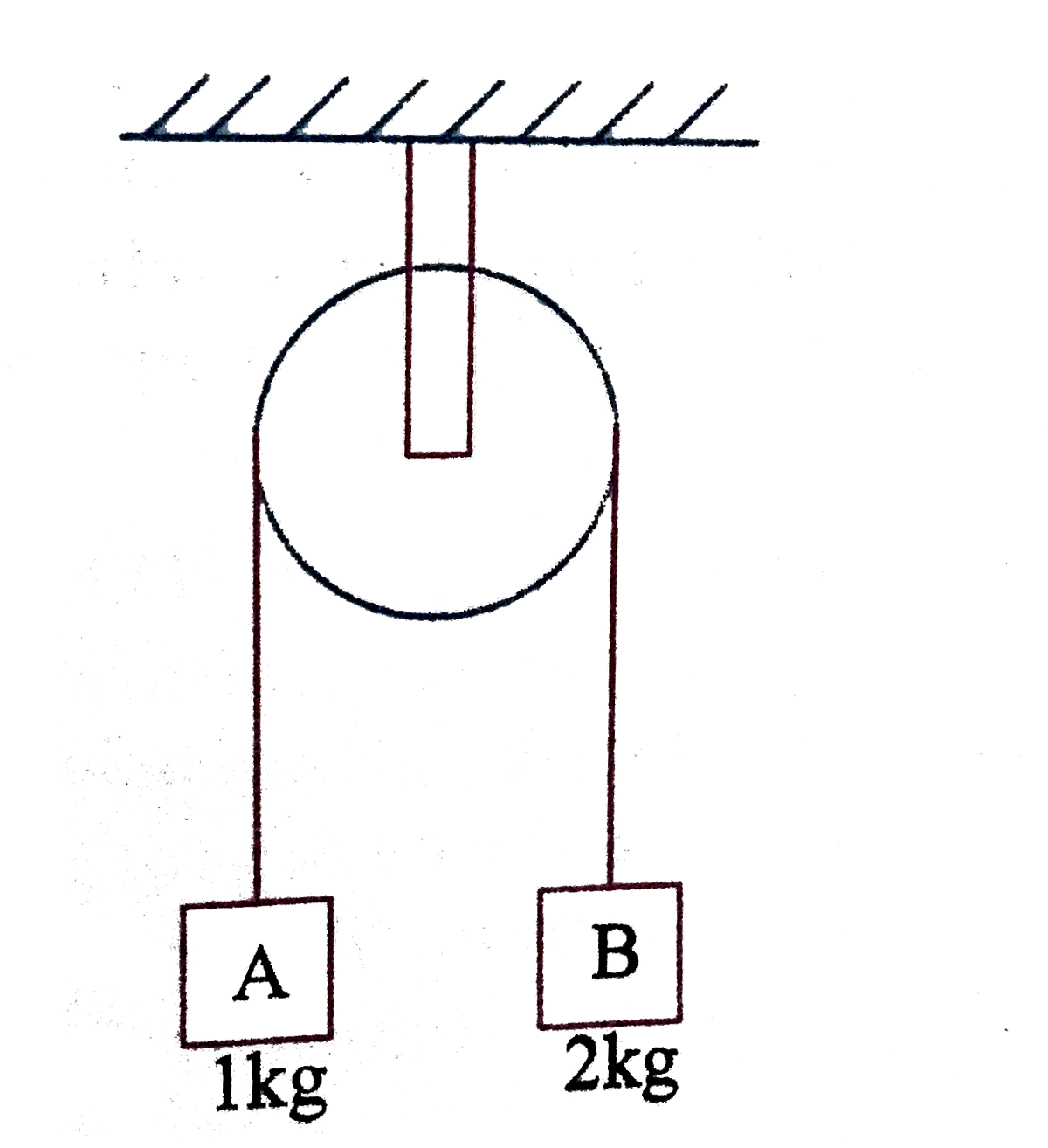In the arrangement shown in figure, string is light and inextensible and friction is absent every where. The speed of both blocks after the block 'A' has ascend a height of 1m will be (g=10m/s2)

Friction is absent. Therefore, mechanical energy of the system will remain conserved. From constraint relations we see that speed of both the blocks will be same. Suppose it is v. Here gravitational potential energy of 2 kg block is decreasing while gravitational potential energy of 1 kg block is increasing.
Similarly, kinetic energy of both the blocks is also increasing.
∴mBgh=mAgh+12mAv2+12mBv2
or (2)(10)(1)=(1)(10)(1)+12(1)v2+12(2)v2
or 20=10+0.5v2+v2 or 1.5v2=10
∴v2=6.67m2s−2 or v=2.58ms−1
Topper's Solved these Questions
- WORK, ENERGY AND POWERBOOK - DC PANDEYCHAPTER - WORK, ENERGY AND POWEREXERCISE - CHECK POINT 6.1
20 Videos
- WORK, ENERGY AND POWERBOOK - DC PANDEYCHAPTER - WORK, ENERGY AND POWEREXERCISE - CHECK POINT 6.2
20 Videos
- WORK, ENERGY & POWERBOOK - DC PANDEYCHAPTER - WORK, ENERGY & POWEREXERCISE - Level 2 Comprehension Based
2 Videos
- WORK, POWER AND ENERGYBOOK - DC PANDEYCHAPTER - WORK, POWER AND ENERGYEXERCISE - E Integer Type Questions
11 Videos
Similar Questions
In the arrangement shown in Figure, mA=2kg and mB=1kg. String is light and inextensible. Find the acceleration of centre of mass of both the blocks. Neglect friction everywhere.

View SolutionIn the arrangement shown in figure. The strings are light and inextensible. The surface over which block are placed is smooth.Find
(a) the acceleration of each block,
(b) the tension in each string.

View Solution
Knowledge Check
In the arrangement shown in figure, string is light and inextensible and friction is absent every where. The speed of bothblocks after the block 'A' has ascend a height of 1m will be (g=10m/s2)
 A2m/sB2.58m/sC3m/sD3.58m/s
A2m/sB2.58m/sC3m/sD3.58m/sSystem shown in figure is released from rest . Pulley and spring is massless and friction is absent everywhere. The speed of 5kg block when 2kg block leaves the contact with ground is (force constant of spring k=40N/mandg=10m/s2)
 A√2ms−1B2√2ms−1C2ms−1D4√2ms−1
A√2ms−1B2√2ms−1C2ms−1D4√2ms−1In the arrangement shown in fig. The strings are light and inextensible. The surface over which blocks are placed is smooth. Find:

(a) the acceleration of each block.
(b) the tension in each string.Aa=4ms−2 b=16N , 24NBa=6ms−2 b=12N , 24NCa=−4ms−2 b=16N , 12NDa=−5ms−2 b=26N , 24N
For the system shown in the figure, the inclined plane is fixed, all the pulleys are light and friction is absent every where.The tension in the string will be

View SolutionIn the arrangement shown in the figure, the blocks have masses 3m,m and 2m, the friction is absent, the masses of the pulleys and the threads are negligible. Find the acceleration of mass 3m.

View SolutionIn the arrangment shown in figure, mA=1 kg, mB=4 kg. String is light and inextensible while pulley is smooth. Coefficient of friction between block A and the table is μ=0.2. Find the speed of both the blocks when block B has descended a height h=1 m. (Take ,g=10 ms−2)

View SolutionSystem shown in figure is released from rest . Pulley and spring is massless and friction is absent everywhere. The speed of 5kg block when 2kg block leaves the contact with ground is (force constant of spring k=40N/mandg=10m/s2)

View SolutionIn the arrangement shown in figure, there is a friction force between the blocks of masses m and 2m. The mass of the suspended block is m. The block of mass m is stationary with respect to block of mass 2m. The minimum value of coefficient of friction between m and 2m is

View Solution